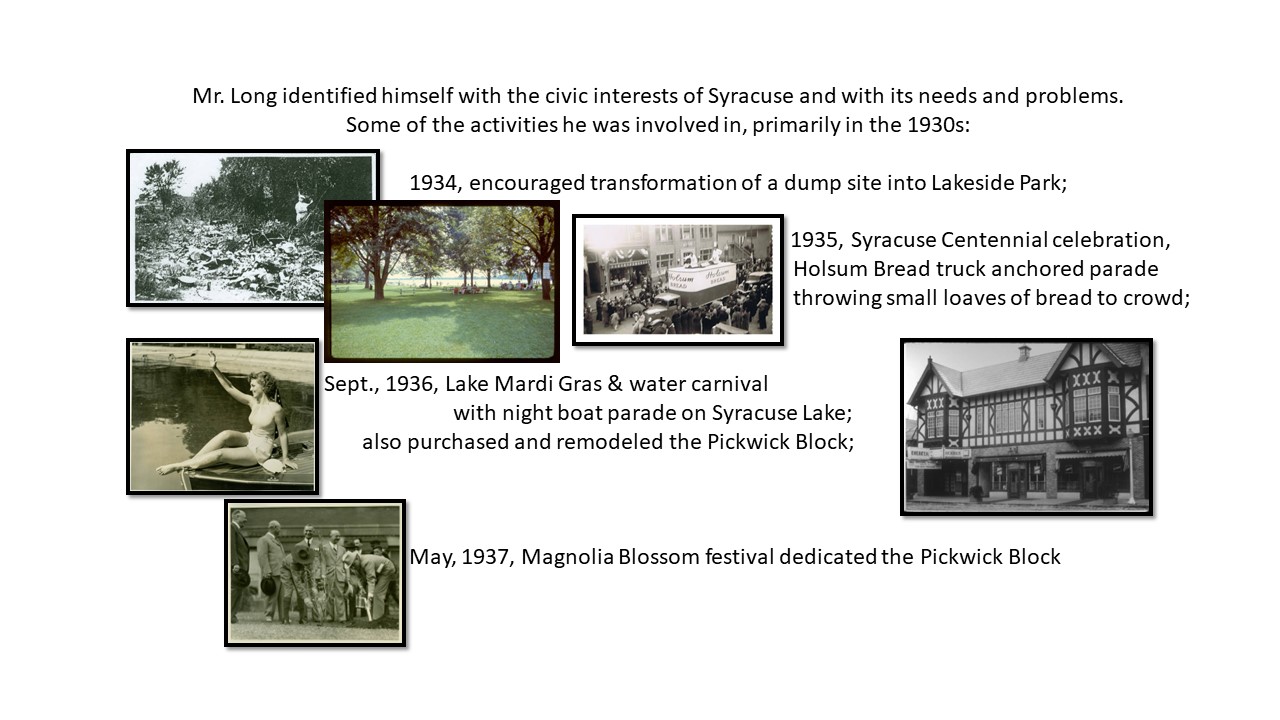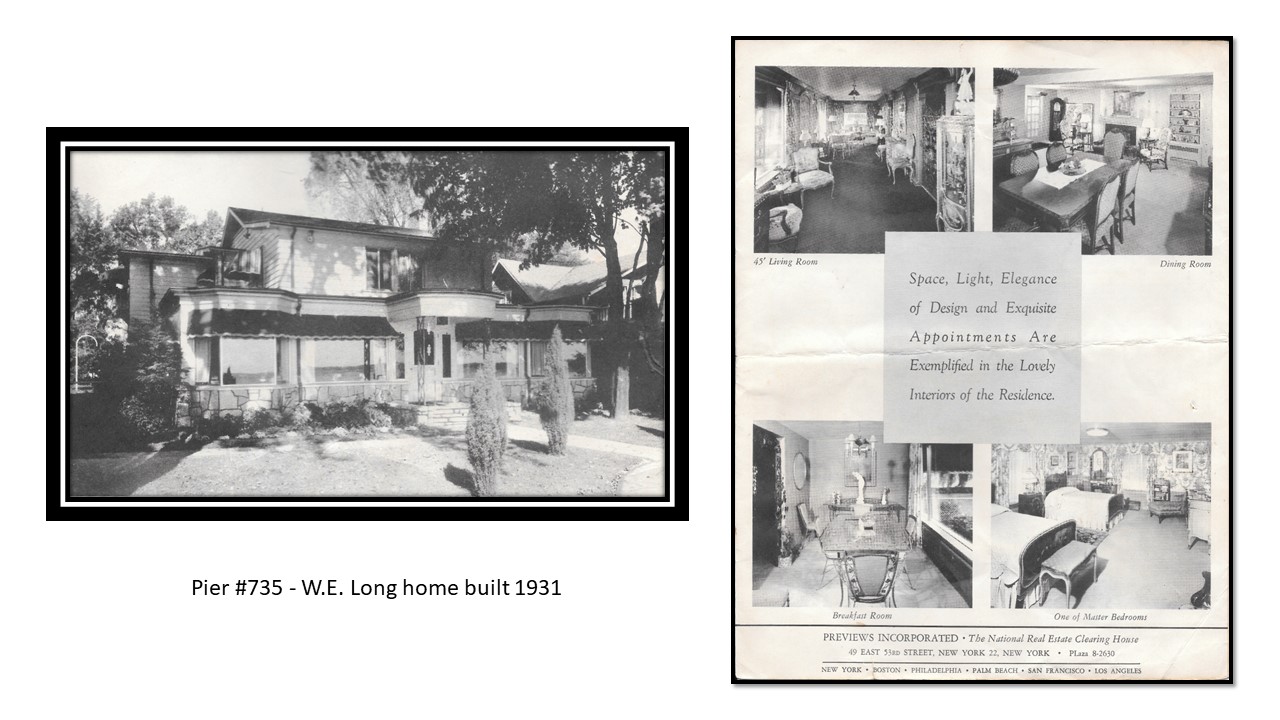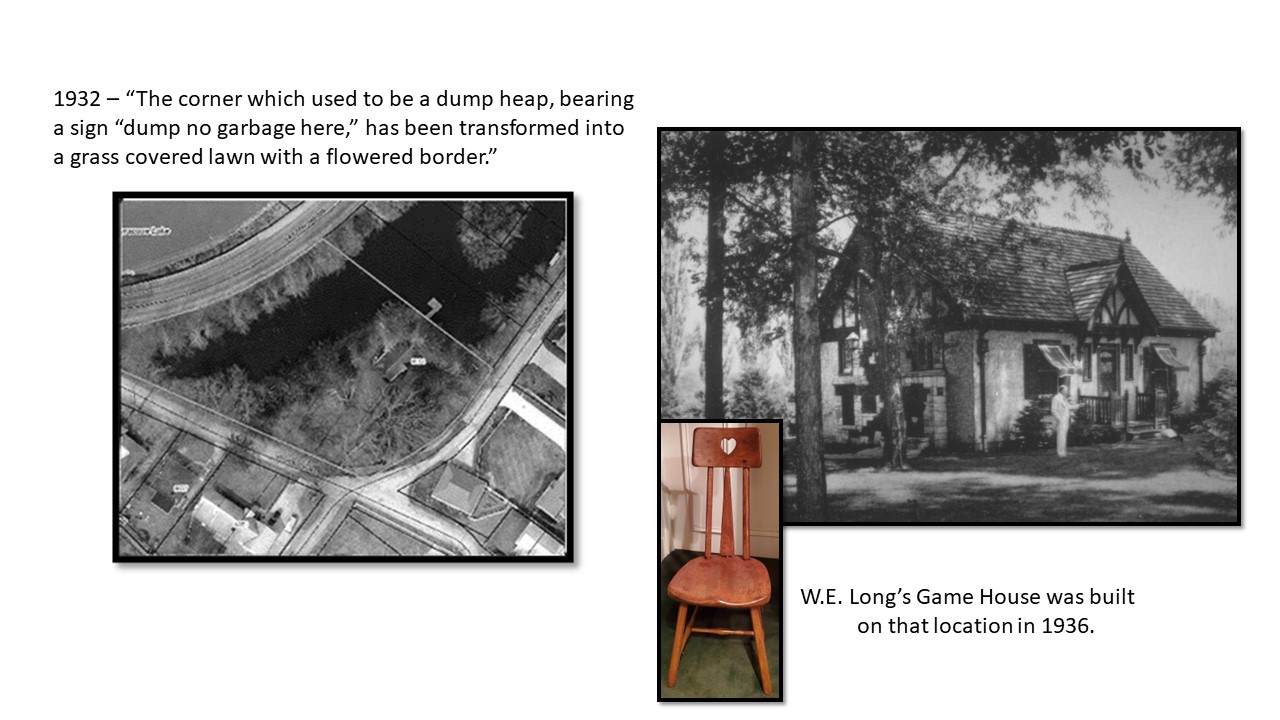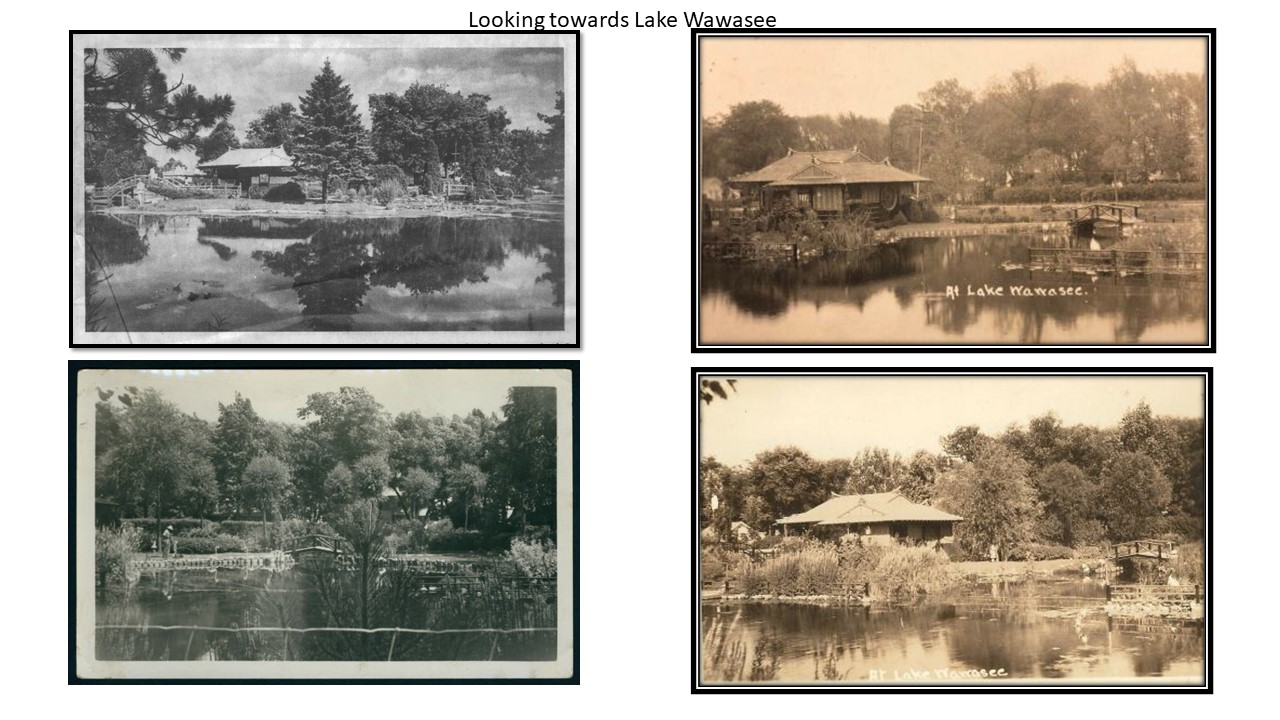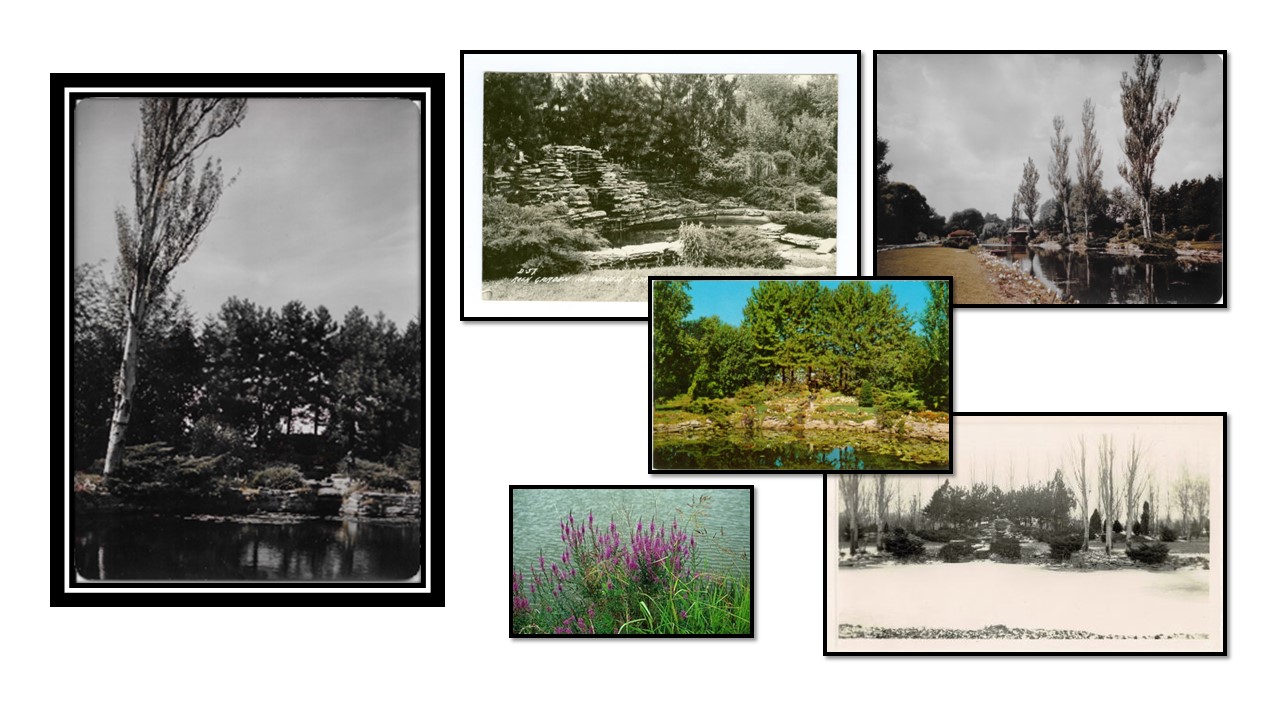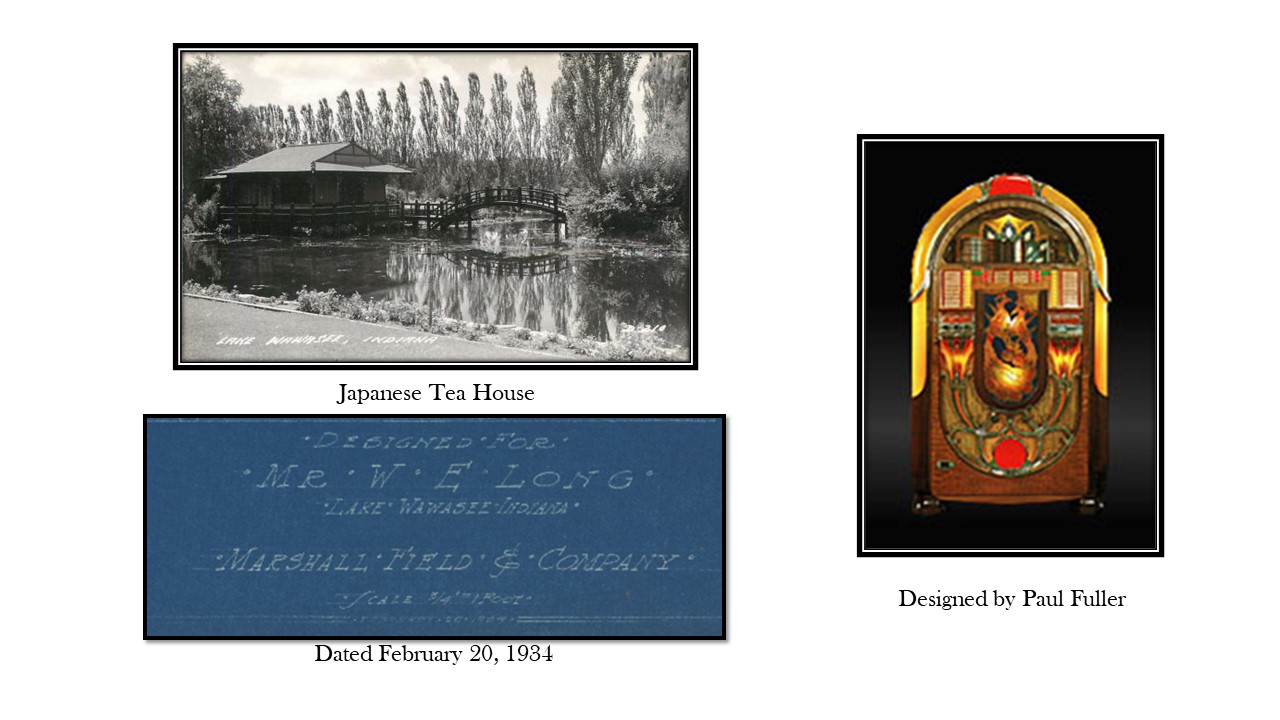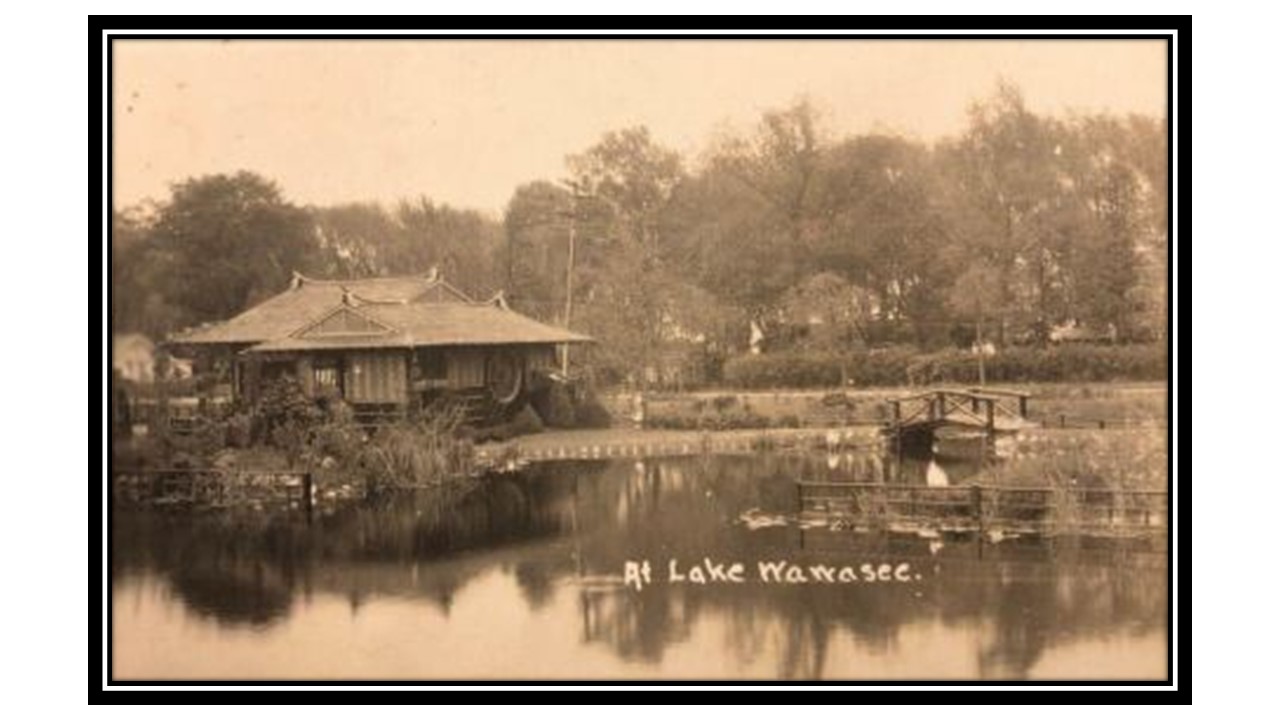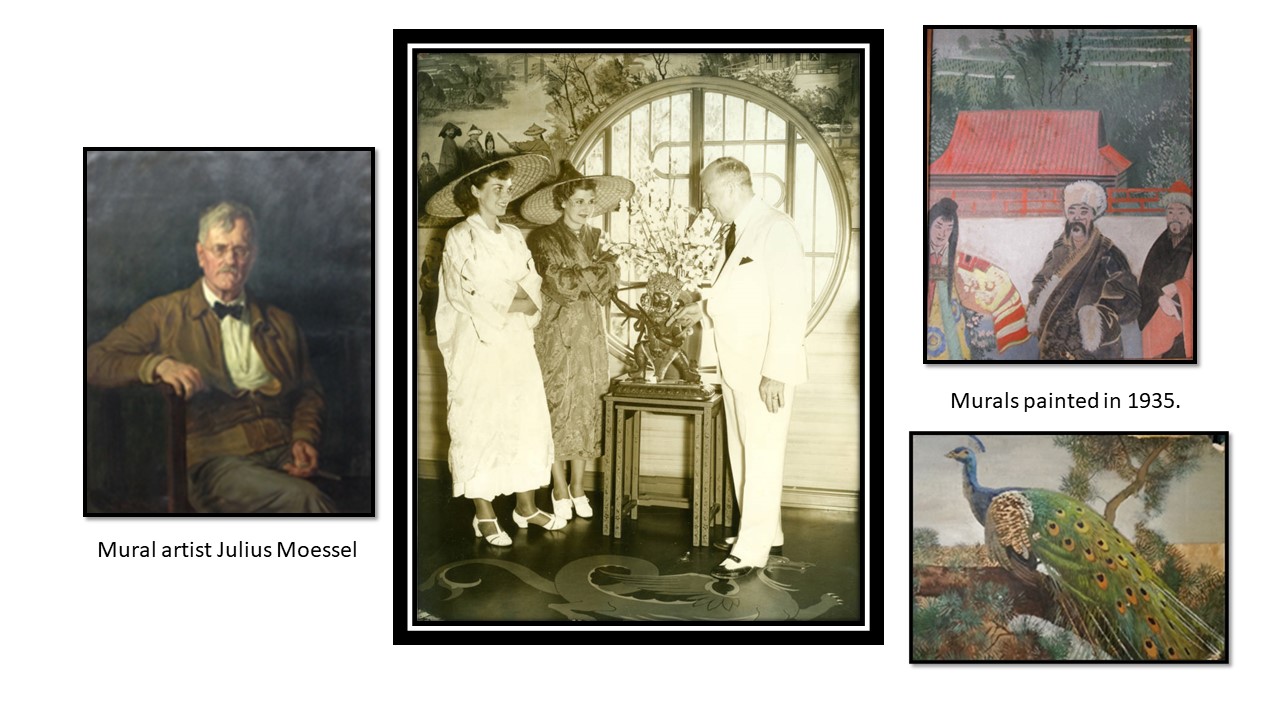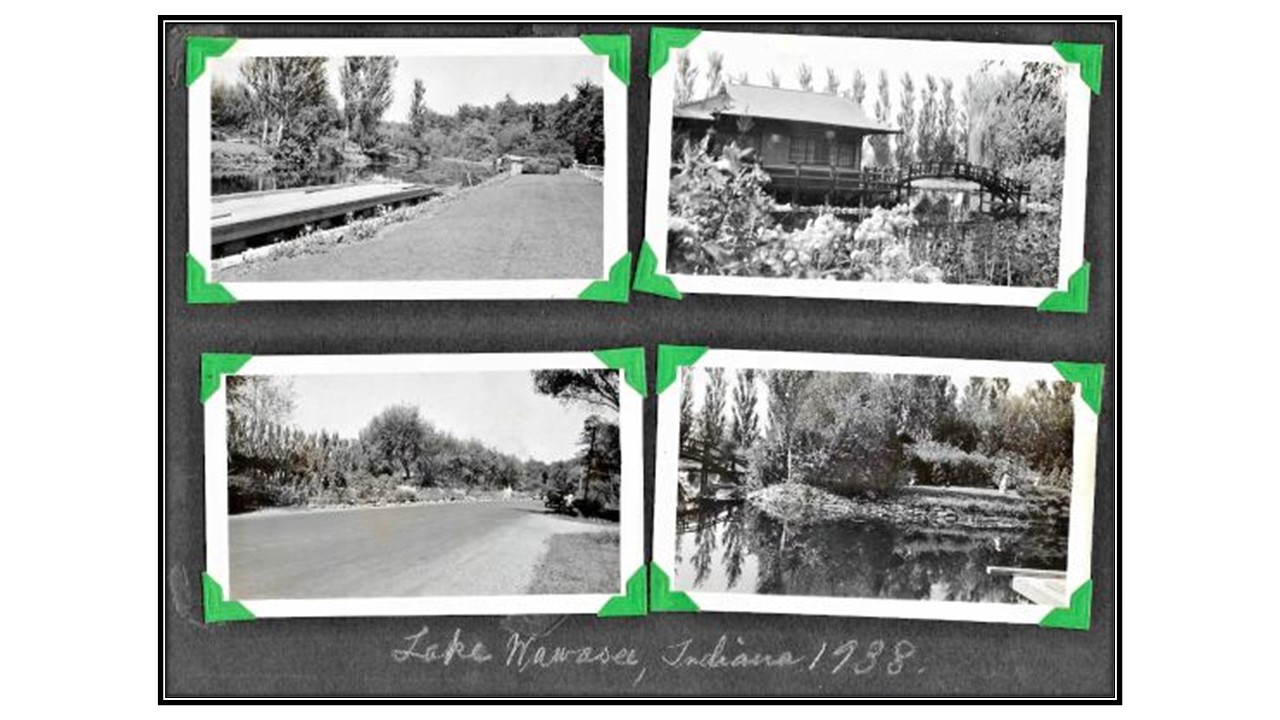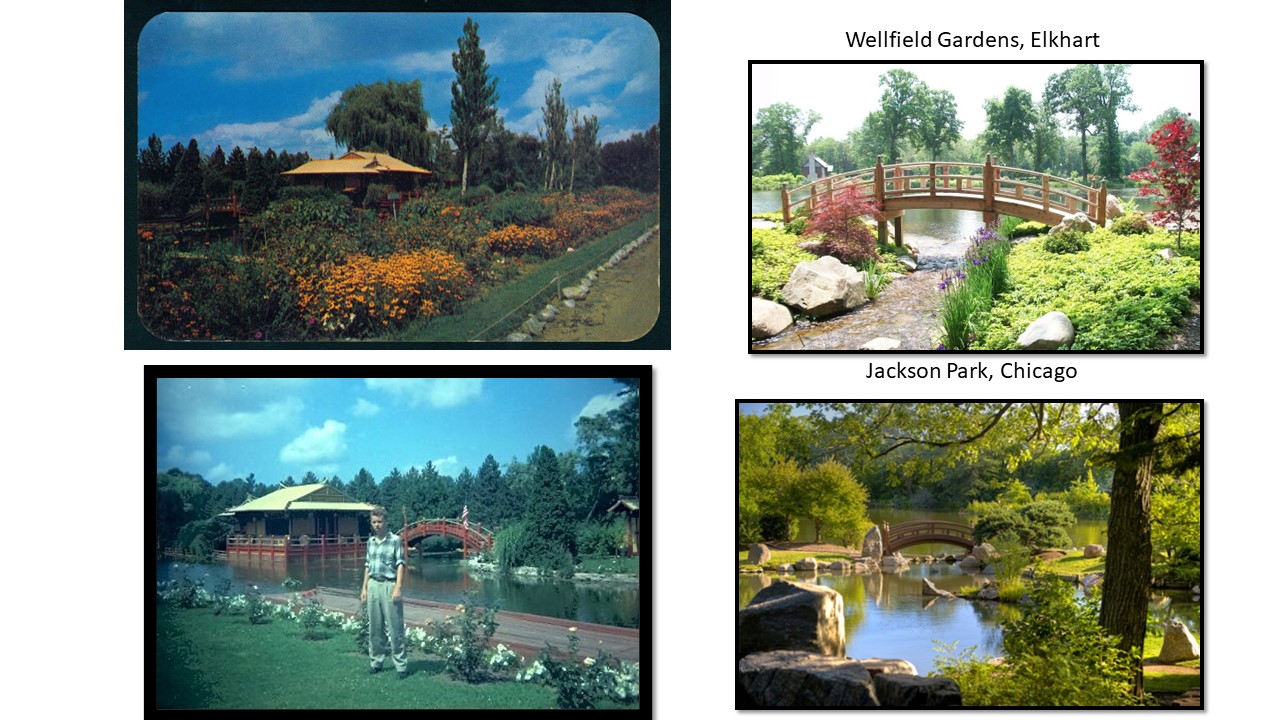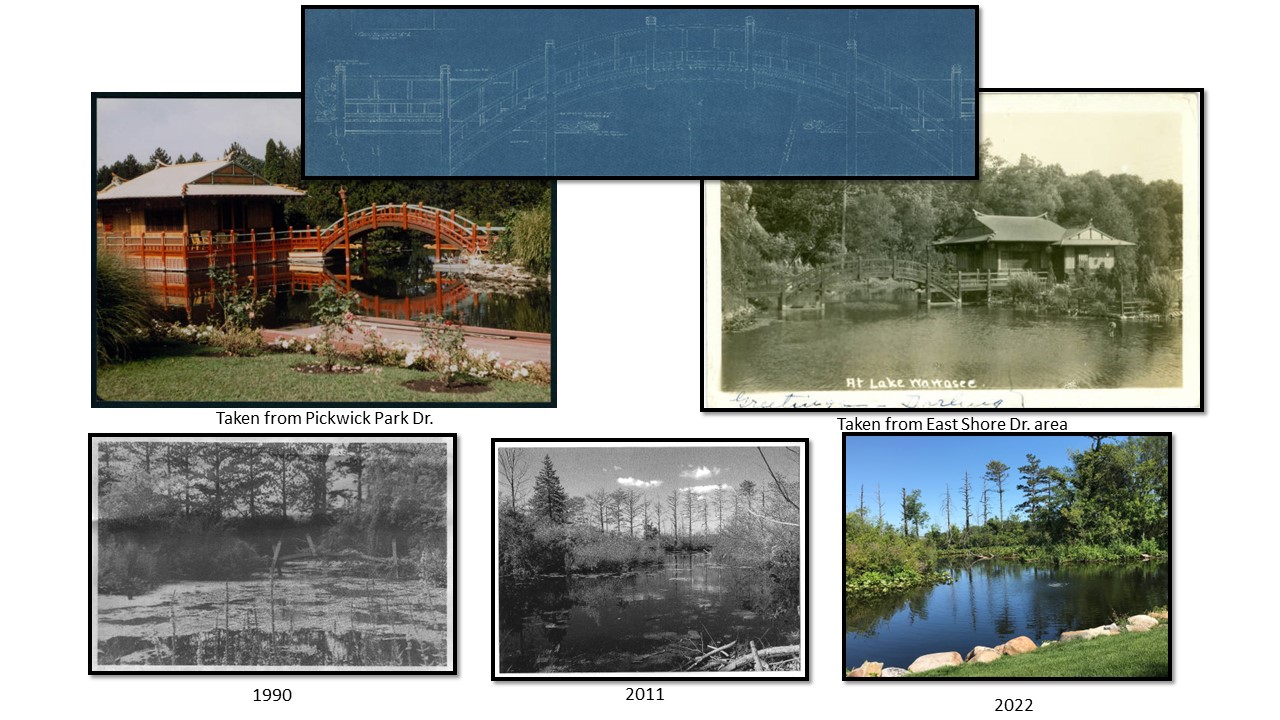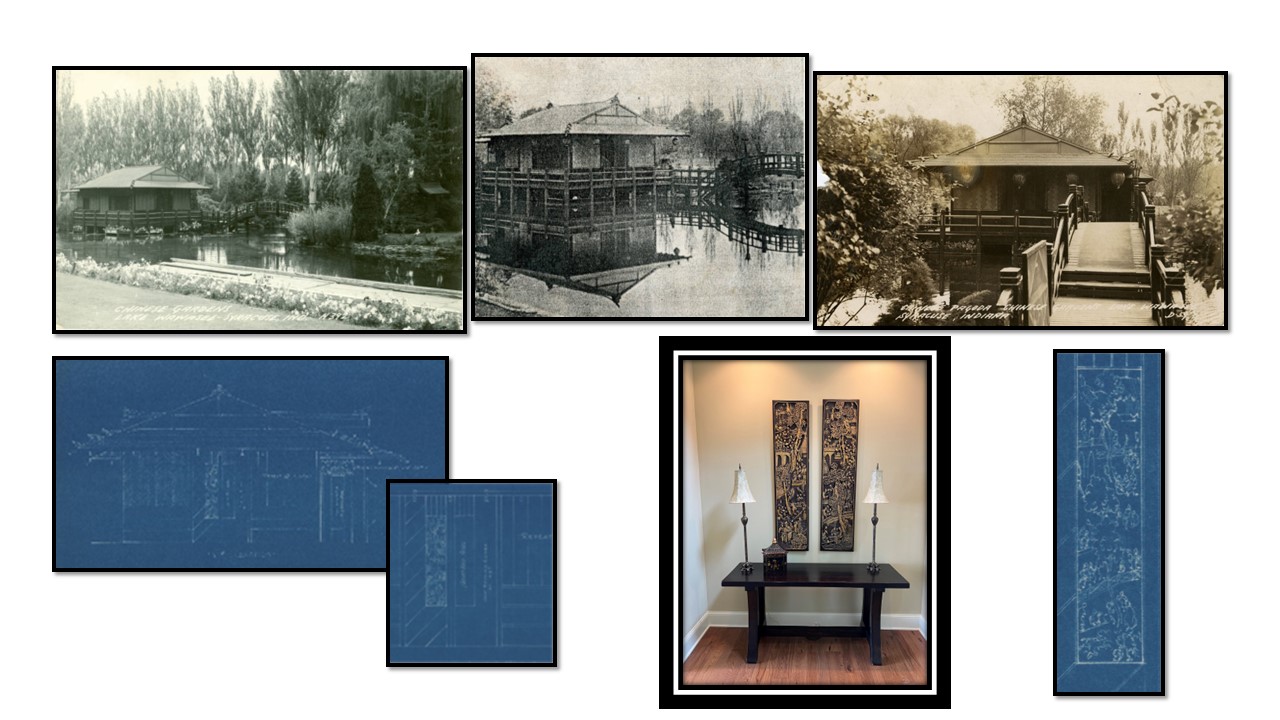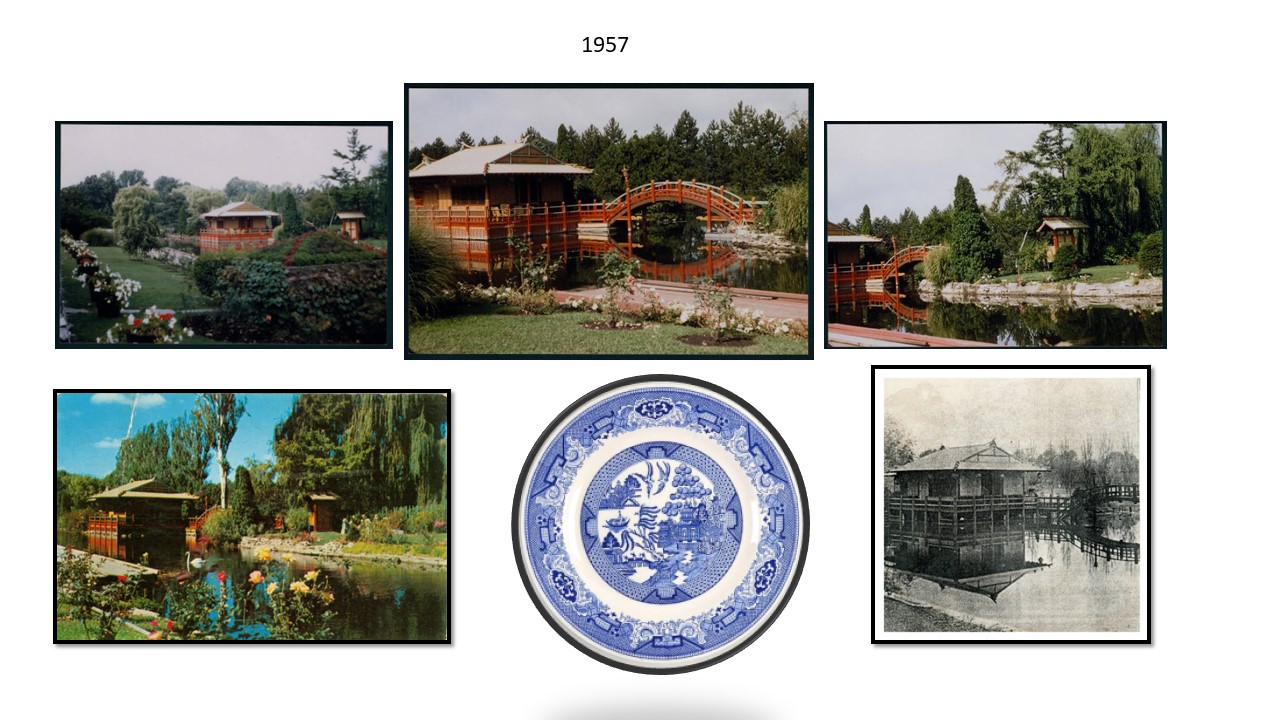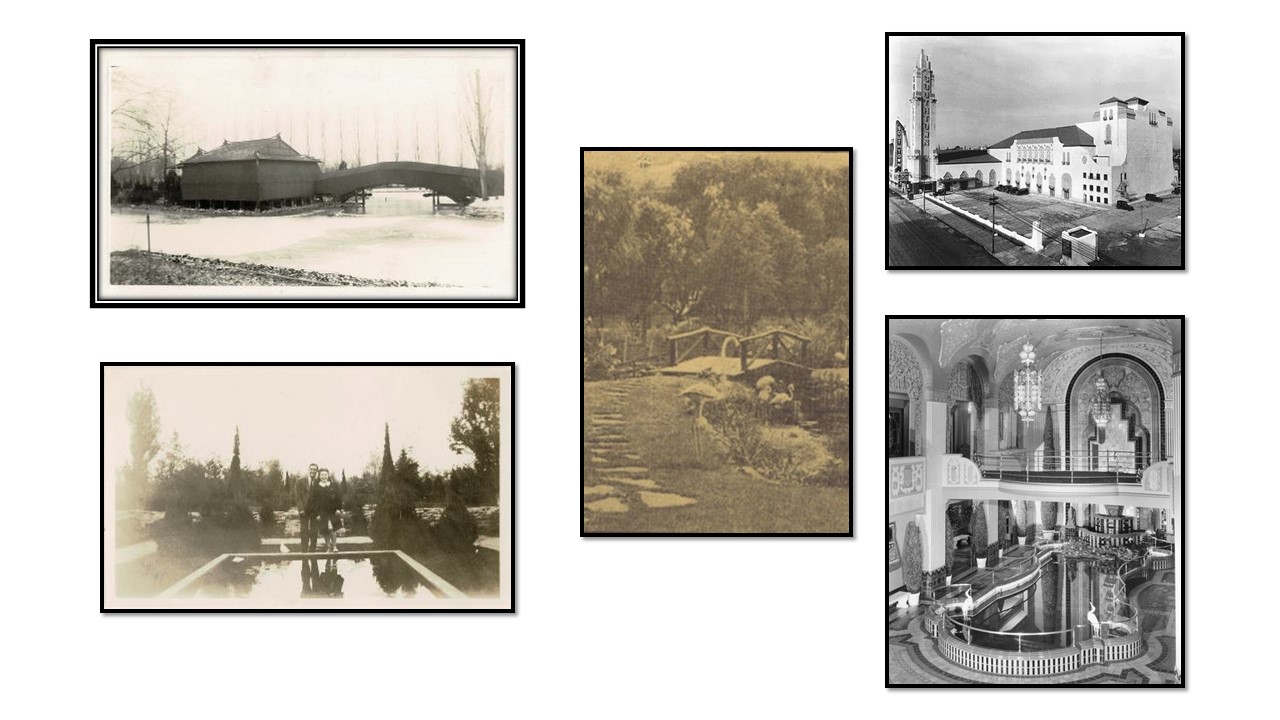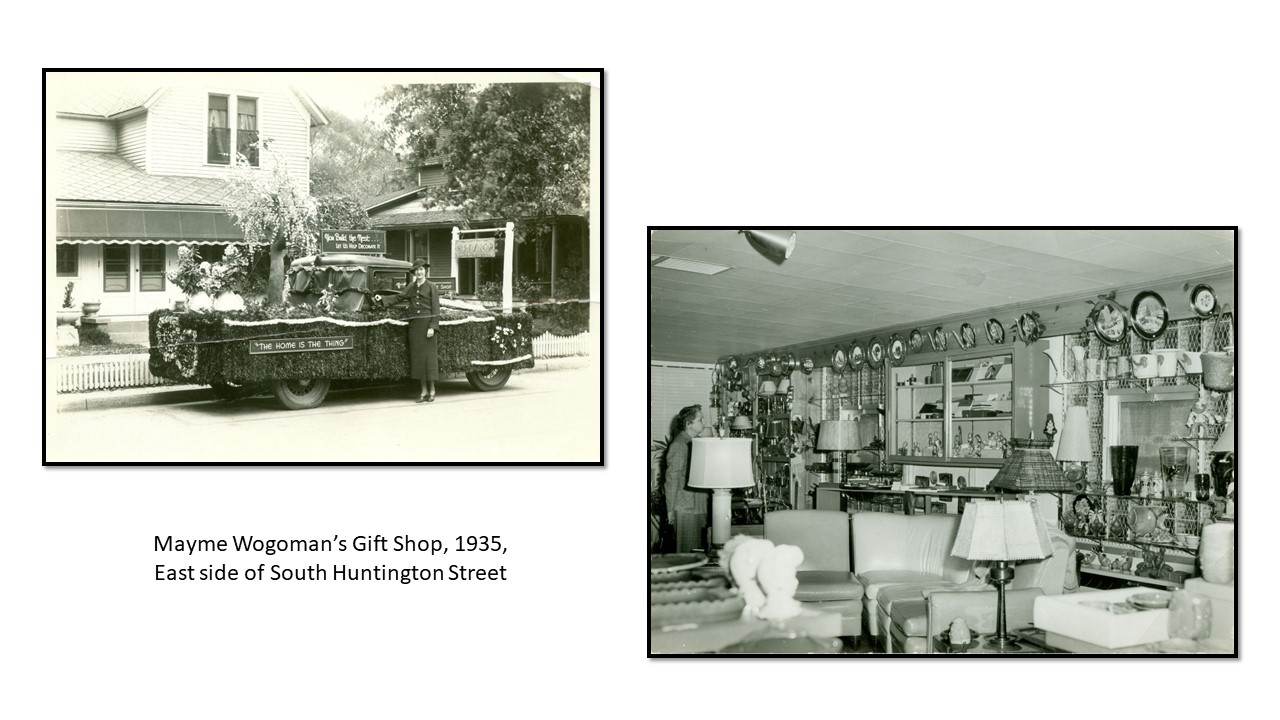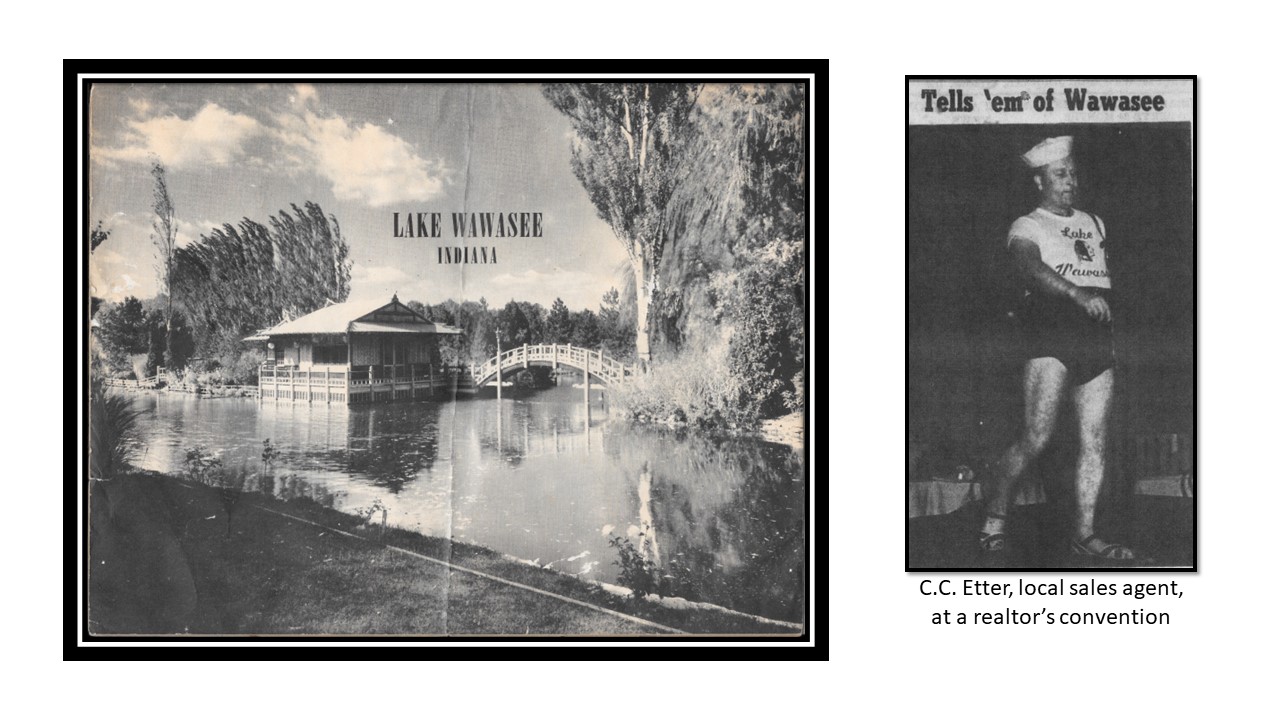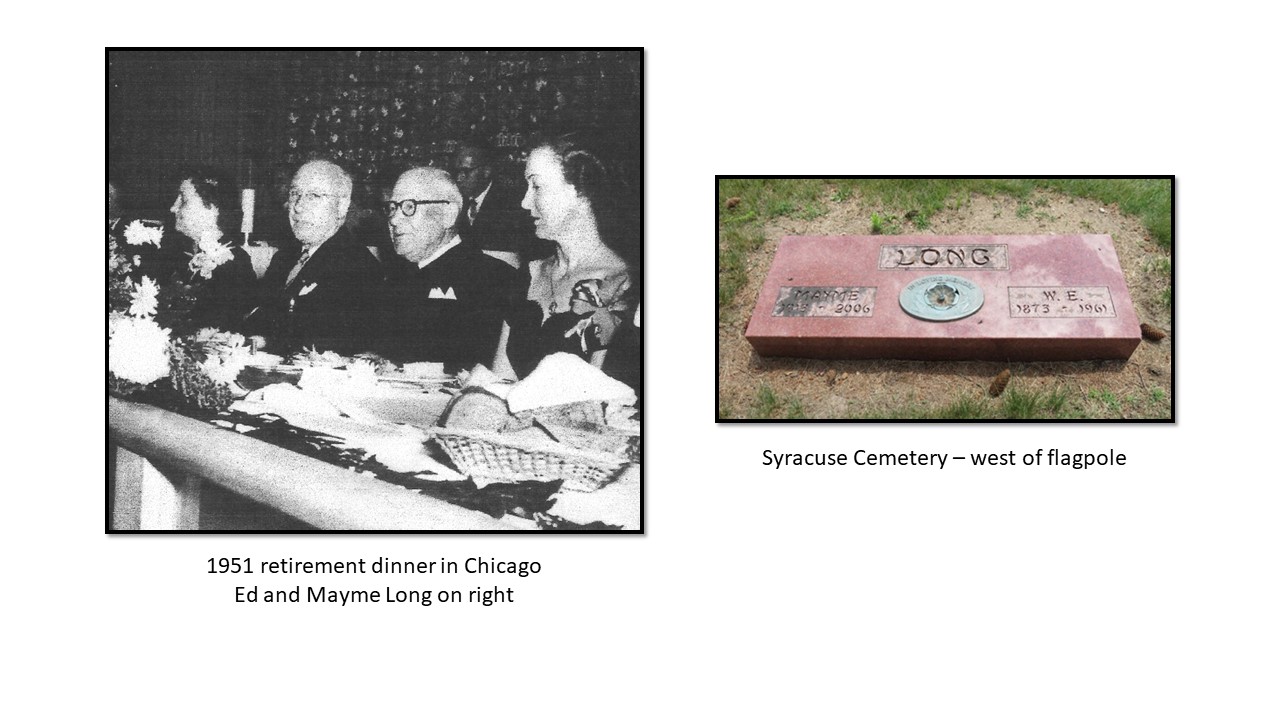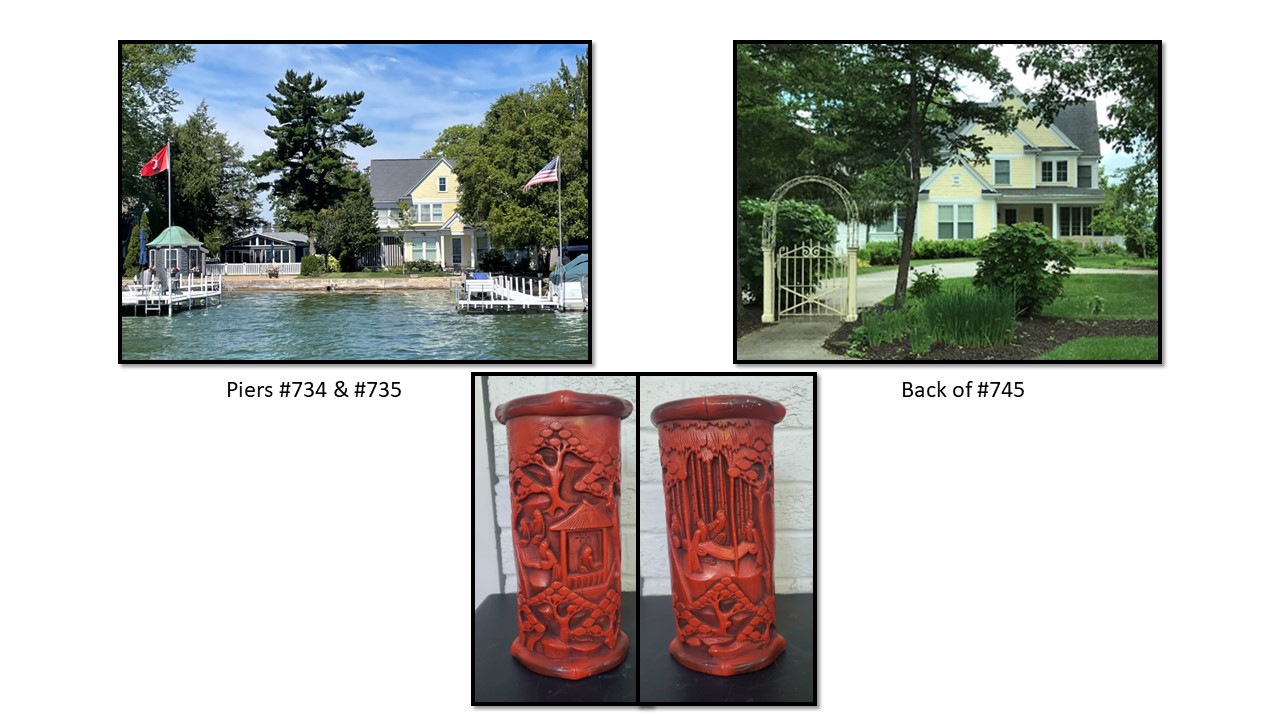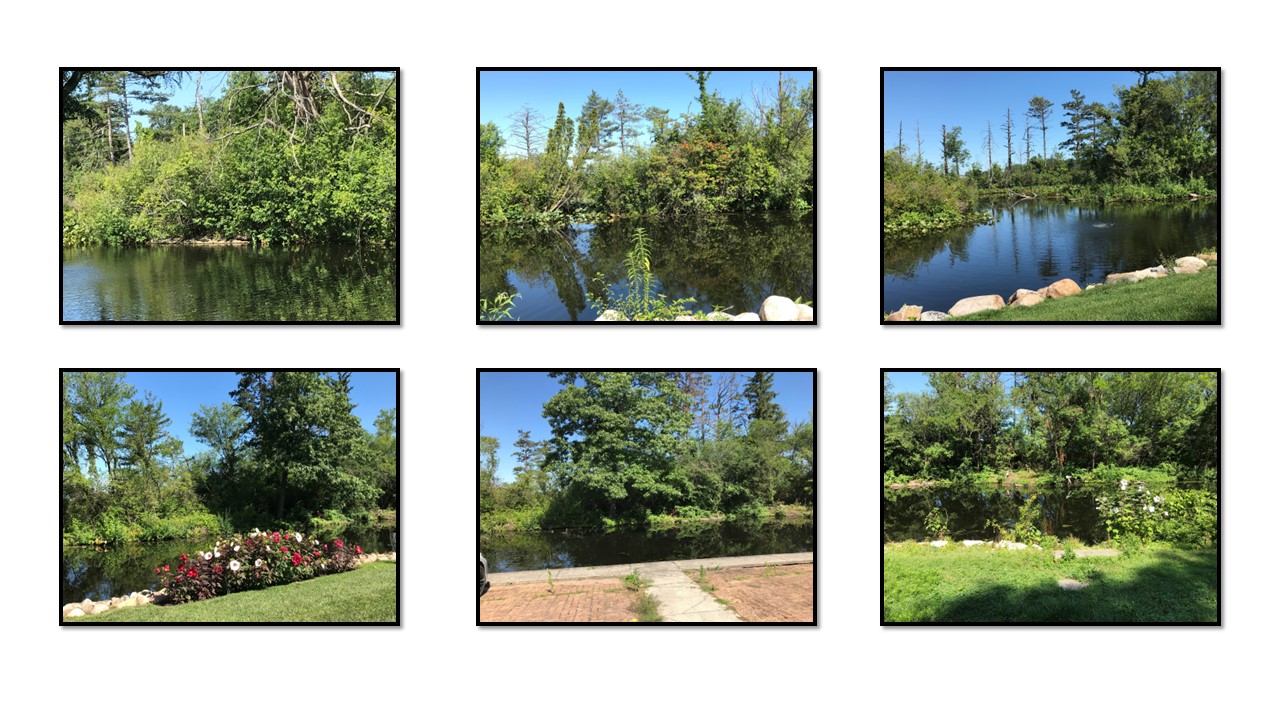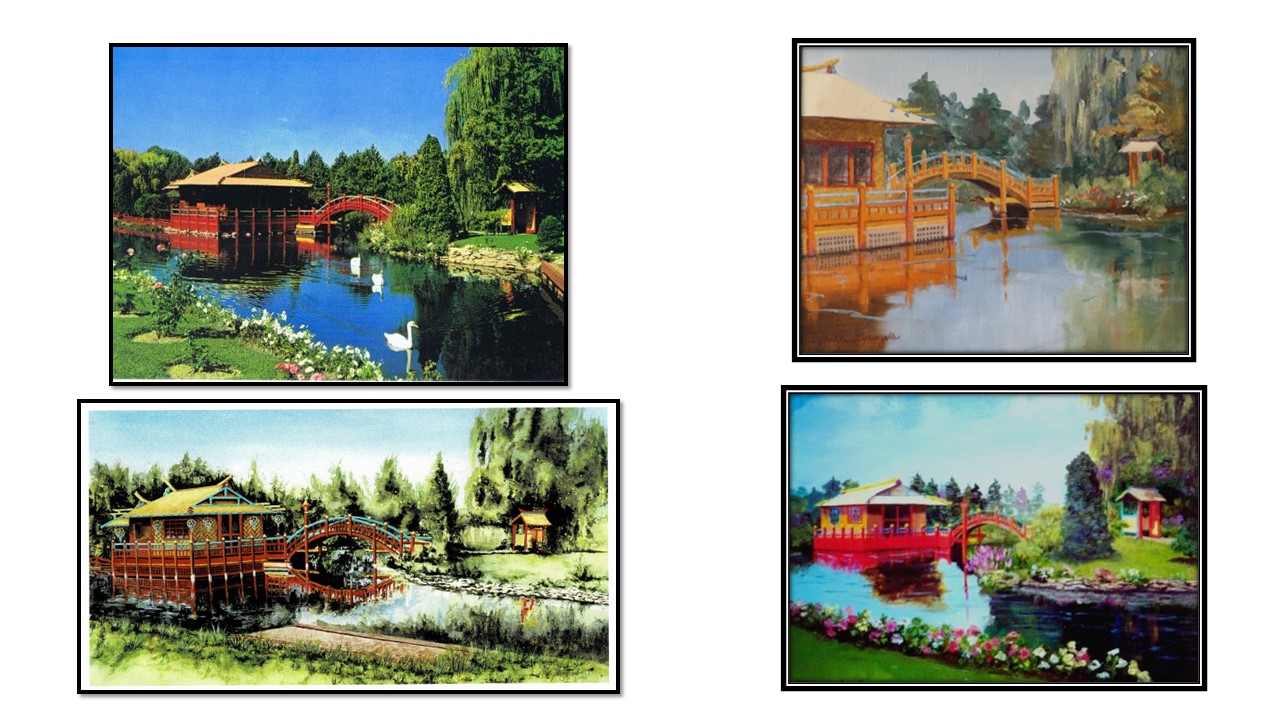Chinese Gardens
A Centennial Presentation – August 13, 2022
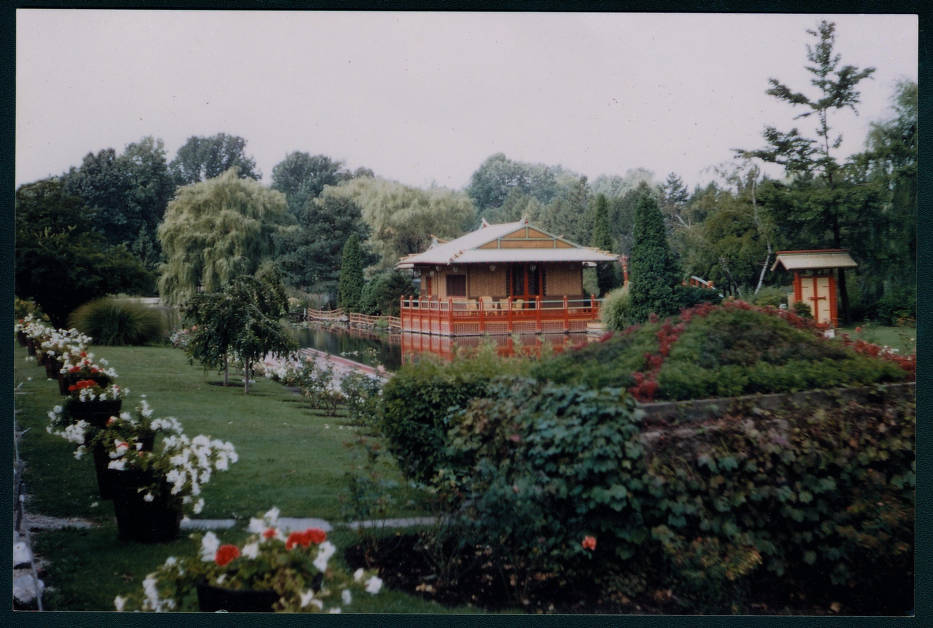
The Pagoda and Gardens, circa 1957
W.E. Long moved to Chicago in 1894 and got a job as a bakery wagon driver. In 1900, he founded the W.E. Long Co.; an Independent Bakers’ Cooperative that’s still in business today. Eight years later, he obtained the exclusive rights for the Holsum bread name. Mr. Long came to Lake Wawasee in 1927 and is listed on Kale Island in the 1928 lake directory; the same year his company pioneered and promoted the packaging of sliced bread.
Even though the country was in the midst of the Great Depression, he was very active in the lakes’ area in the 1930s.
Pickwick Road (now called East Shore Drive) was built in the late 1920s. The dredging of this road across the swamp to the west of Long’s home left islands between the old and new road, which he filled, planted and beautified, giving a picturesque background for all Kale Island property owners. On the new road, parallel with his home, Lombardy poplars and hemlock trees were planted. It was at his expense that this new road extended from the south end of his property to the B&O Railroad.
Mr. and Mrs. Long built their main house on the lake in 1931. It came to be called Bonnie Brae cottage. In putting together this history of the Chinese Gardens, I’ve used various newspaper articles, a Chamber tribute booklet, a 1950 sales brochure loaned by Shelly and Scott Rogers, and photos from our Indiana Memory site – many contributed by Garry Ringler plus new photos from Mike Mock.
Let’s begin with a quote from 1935: “People who have lived in Syracuse or have spent vacations at Wawasee in the last five years, have watched with appreciation, the beautification of property on Kale Island, near the Pickwick Park entrance. The corner which used to be a dump heap bearing a sign “dump no garbage here” has been made into a grass covered lawn with a flowered border.” W.E. Long’s Game House was built on that location in 1936, and we’re delighted to have owner Annette Sinn share how she has transformed it into her home. The chair will be a surprise to Annette; just yesterday a lady emailed me this picture. Watch for it in her pictures!
More about the property’s beautification goes like this: “An island at the rear of Mr. Long’s property and that of his immediate neighbors was built from the marsh (using 1,500 loads of dirt and three and a half carloads of stone as fill). A Chinese house was built on the island; along with a sunken garden, trees, shrubs and flowers were planted; swans, flamingoes and wild ducks made their home near the Chinese house.
Noted Chicago landscape artist Kenneth W. Bangs was employed to design the gardens. Local men did the work, including Henry Beer, a landscaper from Milford, Merton Meredith, a stone mason, and caretaker Jesse Rex, Anna Sudlow’s father. The gardens contained a wide assortment of nature’s beauties including purple loosestrife – native to Asia, but invasive in wetlands – willow, birch and Chinese gingko trees. Among the improvements installed on the largest island were a waterfall formed by a flowing well, a big fish pond, and a lily pond. A beautiful fountain, figurines, and a brightly colored bird house completed the Oriental setting.
The S-WHM has the original architectural plans for the tea house: note – Japanese tea house dated Feb. 20, 1934. I can see how later during WWII that could have caused a stir. I will say, that in all my research, the tea house or pagoda was referred to as Mr. Long’s Chinese House, probably because he collected Chinese artifacts. The designer, Paul M. Fuller, worked for Chicago’s Marshall Field & Co. Later Fuller became the dean of jukebox designers, discovering the eye-appealing features of shimmering, translucent Catalin plastic and bubble tubes.
July 19, 1935
On June 15, 1934, during a Syracuse Chamber of Commerce meeting held in the Chinese pagoda, there was a dedication of the island. Mr. Long invited any civic body which had as its purpose the development of the lakes area to use the pagoda for its meetings.
For several weekends in the Fall of 1935, artist Julius Moessel came from Chicago to Lake Wawasee with Mr. Long to decorate the walls of the Chinese house. The hand painted murals depicted the Chinese natives and various birds.
Here’s a quote from a Sept. 4, 1936, newspaper article: “A Chinese Museum (first of its kind in Indiana) was recently completed on the W.E. Long estate at a cost of $50,000 – equivalent to a little over a million dollars today ($1,065,741.01).
The Chinese Museum is built on an island, which practically duplicates the wooded island in Jackson Park, Chicago – *shown here; (nearby is this bridge in Elkhart’s Wellfield Park); in addition to the museum, which contains many Chinese relics, are lotus beds in the adjacent lagoon which also contain flamingoes, swans and other wading birds, and a typical Oriental garden, planted with flowers imported from the Orient. The Chinese gardens will be open to the public, without charge. The contents of the museum are of such a costly nature that they are to be removed to vaults at the close of the summer season to remain until spring when they will again be restored to the museum.”
Other articles added more details about the pagoda equipped as a tea house for entertainment: “To reach the tea house, guests needed to cross the lagoon by a barge/pontoon and pass through the wishing gate filled with superstition. Many believed that if a person made a wish the first time thru, it would most definitely come true. Upon passing the wishing gate, guests would walk over the arched garden bridge – *note the dragons. The Chinese house was well lighted and admiration of it – its carved doors imported from China, the dragon pictured on its floor inlaid in brick colored linoleum, the furniture with which it was equipped – was expressed by each one who viewed the house.”
“On its French doors located on the front – east side – of the building were hand carved gold-colored panels titled “The Tree of Life” – each panel told the story of Manchurian farmers fighting bandits; the panels were removed from an ancient Chinese shrine which was over 400 years old.” The actual panels still hang in an area home, won in a poker game by a previous owner! Many art pieces decorated the inside of the pagoda including a hand painted chandelier in the main room and an ornate Oriental hand carved chair. The tea house consisted of one main room, a small kitchenette, a bar, a built-in ice box, and a half-bath. It also served as a party house, hosting many business meetings and social gatherings.
The property’s 1950 sales brochure offers even more description of the Chinese Gardens: “Behind the residence, the grounds have been laid out to form an inland lagoon with a chain of three small islands; the most fascinating of the islands has been made a perfect little Chinese garden with lanterns, carved bridges, a reflection pool surrounded by Chinese figures and flamingoes and an authentically designed pagoda overhanging the water. The exotically beautiful Chinese House is built at the edge of the quiet waters of the man-made channels. The interior, furnished in keeping with the oriental mood of the Island home, contains a rare collection of Chinese art – consisting of paintings, tapestries, statuary and pottery. The Chinese Island of Fairyland beauty, with its artistically carved Far East bridges and beckoning verandas, is also a haven for brilliant oriental birds and water fowl that are habitants of this exquisite island gem.” *You may be familiar with Willow Ware.
In 1935, the flamingoes wintered over in Chicago’s Southtown Theater; sometimes they were sent to Florida for the winter – which makes sense since the Longs wintered in Sarasota later in life. At one time, Mr. Long even had peacocks that roamed the gardens. However, due to the commotion they raised – they sound like a crying baby – and the outrage of neighbors, the peacocks were soon dispersed.
W.E. Long’s wife, nee Lida Flowers, died in Nov., 1944; her obituary listed a daughter, Mrs. Mary Beard (Mrs. Robert H.) In 1947, Mr. Long married a local girl, Mayme Wogoman. For some time, she had had a gift shop in Syracuse. Mayme’s brother-in-law, Leonard Stump, became the caretaker.
“In 1949, the WPOA was formed when a few visionary residents accurately predicted that lake use and population would soon increase, and some organization to speak for property owners might be appropriate.” W.E. Long was its founding president. The window they are standing in front of is in a private home in the area.
In Oct., 1950, the Longs offered their entire property for sale ––approximately 3 acres for $150,000. This is the cover for the sales brochure. The local sales representative was C.G. Etter (pictured advertising the area at a relators’ convention).
About this time, Mr. Long retired from his baking business in Chicago. Here in Syracuse, the Longs were beginning to develop Bonnie Brae Estates off SR13 south of town – across from the stone WACF sign. W.E. Long died just ten years later in 1961 at the age of 88. Mayme lived in Bonnie Brae Estates until her death in Sarasota, Florida, in 2006 at age 93. They both are buried in the Syracuse Cemetery west of the flagpole. If you enjoy cemeteries, you can help find and clean markers there in the old section each Saturday from now until Fall. See Garry Ringler for details.
The Long property, complete with the tea house and art collection, was sold at least by 1959 to Ed Gallahue of Indianapolis. In 1964, he offered the gardens to the Pickwick Park Homeowners Association, but they decided not to take on the responsibility for their upkeep. He also tried to give them to a retired professors’ group at Purdue, but they declined. Before selling the gardens to Charles and Jane Nearing of Muncie, with their blessings the Gallahues donated many of the Oriental artifacts to the Indianapolis Children’s Museum in 1965. *Point them out in picture.
“The Nearings kept up the gardens for many years. However, due to their secluded nature, the grounds began to be vandalized, and the tea house finally had to be razed. Mrs. Nearing eventually found persons who were willing to take down many of the ornaments and Chinese designs, adding that she gave much of it away.” I’ve come to believe the teahouse was dismantled approximately 1975, possibly by Jerry Vance and some helpers, one who still lives in the area. He remembered demolition consisted of breaking the teahouse down into small enough pieces to put on a boat that took them off the island. They carefully salvaged as much as they could. The window was the hardest to remove. The murals were glued canvas over drywall, and the only way to save them was to cut them apart. They reportedly saved the dragon heads from the bridge and a post which might still be around. The screen on the right came with a house on Syracuse Lake. The previous owners said it was from the Chinese Gardens. I haven’t found a picture with it in its original location, but I’ll keep looking.
In 1975, Jean & John Swisher bought the W.E. Long property, taking the main house down because of foundation issues and building the present house. Their daughter Ellen has a strong interest in historic preservation. The guest house still stands as built, on a separate property next door. Just yesterday, Ellen texted me the picture of the elegant vase; several pieces belonging to the Long family came with the house.
Here you see the present condition of the islands as you move north along the channel. It was encouraging to find out this summer (2022) that 10 neighbors put in 4 bubblers to keep the channels clear. Debris was taken off the big island this winter while the ice was on. Who knows what will transpire as time goes on!
Reconstructing the history of this fascinating piece of our past has been an adventure. May its memory continue to be passed down through the generations! These are paintings we know of, and I’m sure there are more. The SHS art teacher even took field trips there in the 1960s.
Written in 2022 by Ann Vanderford Garceau for the Syracuse-Wawasee Historical Museum based on historical research. It is not to be used without permission from the museum.


